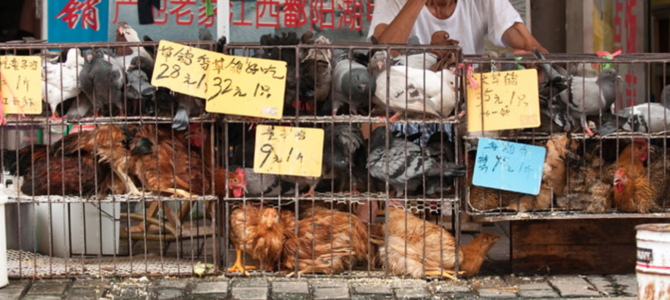
The news of Wuhan reopening its wet markets has caused angst and criticism around the world, because one of the wet markets in the city was identified as ground zero of the COVID-19 pandemic.
Shutting down all wet markets in China is unrealistic. These markets are integral in Chinese people’s culture and way of life. More importantly, we shouldn’t confuse these wet markets with wildlife markets. The majority of wet markets do not sell wild animals. Regardless, a growing number of advocacy groups, politicians, and health professionals are calling for China to shut down wet markets because they believe these markets pose tremendous health risks.
A wet market is a marketplace occupied by different vendors who sell fresh produce, including fruits, vegetables, meat, fish, and other perishable food. You can easily stumble into one whether you are in China or anywhere else in Asia, some countries in Europe, such as Italy, and even some American cities with large immigrant populations.
Wet Markets Play an Important Role in Chinese Culture
When I was growing up in China, my mom went daily to a wet market nearby to buy only what we needed to eat for that day, for obvious reasons: There was no Western-style supermarket available back then, and we couldn’t afford a fridge for many years.
After we bought our first fridge and Western-style supermarkets gradually opened in China, my mom still went to the wet market every day, more for cultural and psychological reasons. Shopping at the market was also a crucial part of millions of Chinese people’s social lives, including my mother’s.
She got to chat with friends and neighbors while shopping, and bargain with the vendors about the price and freshness of each item. Everything is negotiable, and both customers and vendors enjoy the bargaining process. She could converse with the butchers about what specific cut of meat she would like for that day, depending on whether she was going to make a stew or sauté, or if she needed ground meat for making dumplings.
Going to the wet market with my mom was how I learned the art of the deal. She also taught me how to select vegetables and meat, how to plan a meal, the correct time and season to buy what food, and what food should be cooked together. Her mother passed down such traditions and knowledge to her this way, so my mother did the same for me.
On those trips to the wet market, I never saw exotic animals like bats for sale. The market my mom frequented was a very typical one in China. These wet markets do not sell wildlife and exotic animals because those animals are simply not in people’s everyday diets. They are also much more expensive than daily staple foods, making them accessible for the rich but out of reach for ordinary folks.
But there is no denying that in a city with hundreds of wet markets, you can find at least one that sells wild animals. A wildlife market, like the one in Wuhan that became ground zero for coronavirus, is problematic because it sells live and butchered animals right next to each other. Live animals are often crammed in cages, and vendors will sometimes even slaughter them right on the spot. The poor sanitary conditions in wildlife markets and close contact between humans and live and dead animals have made them ideal breeding grounds for infectious diseases.
The Chinese government banned the selling of wild animals after the 2003 SARS outbreak, which also originated from a wildlife market in China. However, the ban was lifted after just three months because of the persistent demand for exotic animals, a demand closely tied to Chinese people’s belief in traditional Chinese medicine, or TCM.
TCM and Wildlife Markets Are Wildly Problematic
The history of TCM can be traced back at least 2,000 years. It emphasizes natural remedies via ingesting plants and animal parts to keep people healthy or cure illness by restoring their inner qi balance (a person’s inner energy system). It is estimated that TCM uses about 1,000 plants and various parts from 36 animal species.
For example, TCM uses tiger bones to treat arthritis and other joint ailments, bear bile for liver ailments and headaches, and seahorse for impotence. Unfortunately, many of these animals are on the endangered species list. Yet that hasn’t stopped some Chinese from consuming them or seeking alternatives from other exotic animals for their perceived “magic” healing powers, despite a significant lack of scientific evidence. Demand from TCM believers helps sustain wildlife markets.
It didn’t help that in 2019, the World Health Organization (WHO) endorsed TCM for the very first time, after years of heavy lobbying from China. Beijing saw such an endorsement as a boost for China’s cultural self-confidence, a promotion of national pride and systemic superiority, and an opening for new TCM markets to aid the “rejuvenation of the great Chinese nation.” WHO’s TCM endorsement has been highly controversial among medical experts because proof of its safety and effectiveness is scant.
Never wanting to let a crisis go to waste, Beijing has been promoting TCM heavily in the midst of the COVID-19 outbreak, claiming it has cured Wuhan virus patients without providing any clinical trial evidence. Conservationists and animal rights activists are concerned that the WHO’s endorsement and Beijing’s politically driven promotion of TCM will elevate the demand for some wild animals and keep those problematic wildlife markets in business.
Wet markets that sell ordinary perishable food are not the problem; the majority do not sell wild animals. They are a way of life and an integral part of many cultures. Calling to shut them down is not feasible. But the consumption of wild animals and non-evidence-based TCM are problematic. We should demand the Chinese government ban the sale and consumption of wild animals and refrain from using TCM to advance Beijing’s political objectives.









